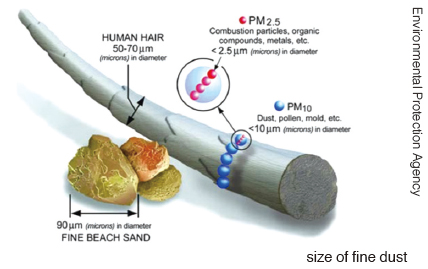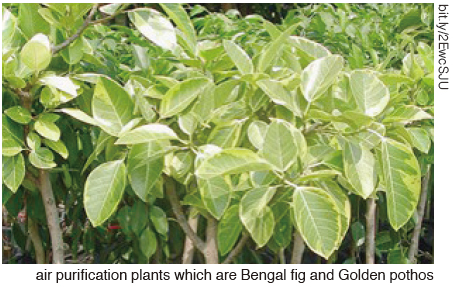Do you wear a mask when you go outside? These days, we often see people wearing masks. This is because fine dust is hitting Korea right now. Articles reporting about fine dust are non-stop. Also, people have become more aware of fine dust and how they are suffering from it. The UOS Times tracked what fine dust is and how dangerous it is.
The concept of fine dust

Then, what is fine dust? To understand the concept of fine dust, we need to have a notion of what dust is first. Dust is a particle that floats in or down the air and fine dust are dust particles that range in size from 0.1 to 2.5 micrometers.
The composition of fine dust can vary depending on regions, seasons and weather conditions. Generally speaking, the ratio of fine dust resulting from air pollutants was the highest at 58.3 percent, followed by carbon and, soot; at 16.8 percent, and minerals at 6.3 percent.
The causes of fine dust

The causes of fine dust are divided into natural and artificial reasons. Natural causes derive from dust, salt from sea water, and pollen from plants. The artificial causes are derived from the smoke that arises after burning fossil fuels in power plants, as well as the flying dust from automobile exhaust, construction sites, and the powdered raw materials from factories.
Furthermore, fine dust creation can be divided into two causative factors. The first causative factor is solid particulate matter from the source; the secondary causative factor is the gaseous substance that reacts chemically with other substances in the air.
We need to focus on the secondary causative factor. The reason why it is important is because the proportion of this factor is so high; it accounts for about two-thirds of the total causes of fine dust.
Three main risks of fine dust
Why is there a lot of discussion in the news on the topic of fine dust? Also, why is the government considering many polices to address fine dust? This is because fine dust has various risks. The hazards of fine dust can be divided into three major categories.
The first danger is that it has an adverse effect on people’s health. The World Health Organization (WHO) announced that 7 million people in a year die earlier than expected due to fine dust. The adverse effects of fine dust on the respiratory tract are mainly in the bronchial tubes. Fine dust exposure can cause diseases such asthma and chronic bronchitis. Also, fine dust is a major factor in cardiovascular diseases such as myocardial infarction, stroke, heart rate abnormalities, and sudden death.
The most common adverse effect of fine dust on human is inflammatory response of the airway. For example, inhalation of fine dust causes an inflammatory reaction in the upper and lower altitudes and increases active oxygen intake while oxidizing stress. In addition, the International Agency for Research on Cancer (IARC) confirmed that fine dust causes cancer. Based on this research, fine dust was classified in October 2013 as one of the most dangerous carcinogens.
The second risk is the adverse effect of fine dust on the ecosystem. Fine dust, which leaves a lot of sulfur dioxide (SO2) and nitrogen dioxide (NO2) in the atmosphere, causes acid rain that acidifies soil and water. It can also cause soil degradation, ecosystem damage, trees and other vegetation detriment. Moreover, if heavy metals, such as cadmium, are carried in the air, they can damage crops and aquatic organisms.
The third risk of fine dust is that it has a bad influence on industrial activity. Above all, fine dust adversely affects the semiconductor industry, auto mobile production, and air travel. Fine dust increases the rate of defective semiconductors, disrupts the automobile manufacturing process by causing malfunctions and hinders airplane operation by reducing visibility.
How to cope with fine dust?

Among the three dangers of fine dust, we should be especially careful of the risks to people’s health. Therefore, how do we manage fine dust in our daily lives? There are four major tips to cope with fine dust in everyday life.
First, in the case of indoor cleaning, use a water mop instead of a vacuum cleaner. If you use a vacuum cleaner when the concentration of fine dust is high, it can cause more dust. So, the water mop will help remove fine dust in our house much more efficiently.
Second, try not to go out as much as you can. If you go out, wear a mask certified by the Ministry of Food and Drug Safety. You must be careful to use the correct mask if you are suffering from respiratory, cardiovascular and asthma disease. It would be best to consult your doctor before choosing a mask.
Third, close the windows to block the inflow of fine dust from outside. However, there is an exception to this tip. If you cook in the house, the indoor fine dust density is greatly magnified. In such a case, mechanical ventilation is recommended because the indoor concentration of fine dust may be higher than the outdoor concentration.
Fourth, grow air purification plants. If you grow air purification plants, they can reduce indoor fine dust. There is a scientific reason why this works. Fine dust with cation sticks to an ion that is generated by plants. The particles will become bigger and heavier and, sink to the ground as a result. This process helps to reduce the fine dust. Some plants that effectively remove fine dust include Stuckyi, Sansevieria, Bengal fig, Golden pothos and Parlour palm.
Readers can overcome the adverse effects of fine dust through these tips. What is important in this situation is how you can cope with the fine dust problem. If we remember and practice how to handle it, we could greatly decrease the adverse of effects of fine dust.
Kang Ju-na
apples707@uos.ac.kr

